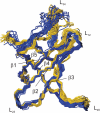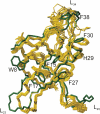Recognition of T-rich single-stranded DNA by the cold shock protein Bs-CspB in solution
- PMID: 16956971
- PMCID: PMC1636342
- DOI: 10.1093/nar/gkl376
Recognition of T-rich single-stranded DNA by the cold shock protein Bs-CspB in solution
Abstract
Cold shock proteins (CSP) belong to the family of single-stranded nucleic acid binding proteins with OB-fold. CSP are believed to function as 'RNA chaperones' and during anti-termination. We determined the solution structure of Bs-CspB bound to the single-stranded DNA (ssDNA) fragment heptathymidine (dT7) by NMR spectroscopy. Bs-CspB reveals an almost invariant conformation when bound to dT7 with only minor reorientations in loop beta1-beta2 and beta3-beta4 and of few aromatic side chains involved in base stacking. Binding studies of protein variants and mutated ssDNA demonstrated that Bs-CspB associates with ssDNA at almost diffusion controlled rates and low sequence specificity consistent with its biological function. A variation of the ssDNA affinity is accomplished solely by changes of the dissociation rate. 15N NMR relaxation and H/D exchange experiments revealed that binding of dT7 increases the stability of Bs-CspB and reduces the sub-nanosecond dynamics of the entire protein and especially of loop beta3-beta4.
Figures






Similar articles
-
Single-stranded DNA binding of the cold-shock protein CspB from Bacillus subtilis: NMR mapping and mutational characterization.Protein Sci. 2003 Jan;12(1):112-23. doi: 10.1110/ps.0219703. Protein Sci. 2003. PMID: 12493834 Free PMC article.
-
T-rich DNA single strands bind to a preformed site on the bacterial cold shock protein Bs-CspB.J Mol Biol. 2006 Jul 14;360(3):702-14. doi: 10.1016/j.jmb.2006.05.044. Epub 2006 Jun 2. J Mol Biol. 2006. PMID: 16780871
-
Single-stranded DNA bound to bacterial cold-shock proteins: preliminary crystallographic and Raman analysis.Acta Crystallogr D Biol Crystallogr. 2004 Apr;60(Pt 4):755-7. doi: 10.1107/S0907444904002422. Epub 2004 Mar 23. Acta Crystallogr D Biol Crystallogr. 2004. PMID: 15039576
-
Mutational analysis of the putative nucleic acid-binding surface of the cold-shock domain, CspB, revealed an essential role of aromatic and basic residues in binding of single-stranded DNA containing the Y-box motif.Mol Microbiol. 1995 May;16(4):699-708. doi: 10.1111/j.1365-2958.1995.tb02431.x. Mol Microbiol. 1995. PMID: 7476164
-
Thermal stability and atomic-resolution crystal structure of the Bacillus caldolyticus cold shock protein.J Mol Biol. 2000 Apr 7;297(4):975-88. doi: 10.1006/jmbi.2000.3602. J Mol Biol. 2000. PMID: 10736231
Cited by
-
Impact of crowded environments on binding between protein and single-stranded DNA.Sci Rep. 2021 Sep 3;11(1):17682. doi: 10.1038/s41598-021-97219-1. Sci Rep. 2021. PMID: 34480058 Free PMC article.
-
Cold-Shock Domains-Abundance, Structure, Properties, and Nucleic-Acid Binding.Cancers (Basel). 2021 Jan 7;13(2):190. doi: 10.3390/cancers13020190. Cancers (Basel). 2021. PMID: 33430354 Free PMC article. Review.
-
One evolutionarily selected amino acid variation is sufficient to provide functional specificity in the cold shock protein paralogs of Staphylococcus aureus.Mol Microbiol. 2020 Apr;113(4):826-840. doi: 10.1111/mmi.14446. Epub 2020 Jan 12. Mol Microbiol. 2020. PMID: 31876031 Free PMC article.
-
Influence of the stability of a fused protein and its distance to the amyloidogenic segment on fibril formation.PLoS One. 2010 Nov 23;5(11):e15436. doi: 10.1371/journal.pone.0015436. PLoS One. 2010. PMID: 21124848 Free PMC article.
-
Single-stranded DNA-binding proteins: multiple domains for multiple functions.Structure. 2013 Jul 2;21(7):1074-84. doi: 10.1016/j.str.2013.05.013. Structure. 2013. PMID: 23823326 Free PMC article. Review.
References
-
- Graumann P.L., Marahiel M.A. A superfamily of proteins that contain the cold-shock domain. Trends Biochem. Sci. 1998;23:286–290. - PubMed
-
- Jones P.G., Inouye M. RbfA, a 30S ribosomal binding factor, is a cold-shock protein whose absence triggers the cold-shock response. Mol. Microbiol. 1996;21:1207–1218. - PubMed
-
- Phadtare S., Inouye M., Severinov K. The nucleic acid melting activity of Escherichia coli CspE is critical for transcription antitermination and cold acclimation of cells. J. Biol. Chem. 2002;277:7239–7245. - PubMed
Publication types
MeSH terms
Substances
LinkOut - more resources
Full Text Sources
Other Literature Sources
Molecular Biology Databases
Miscellaneous

